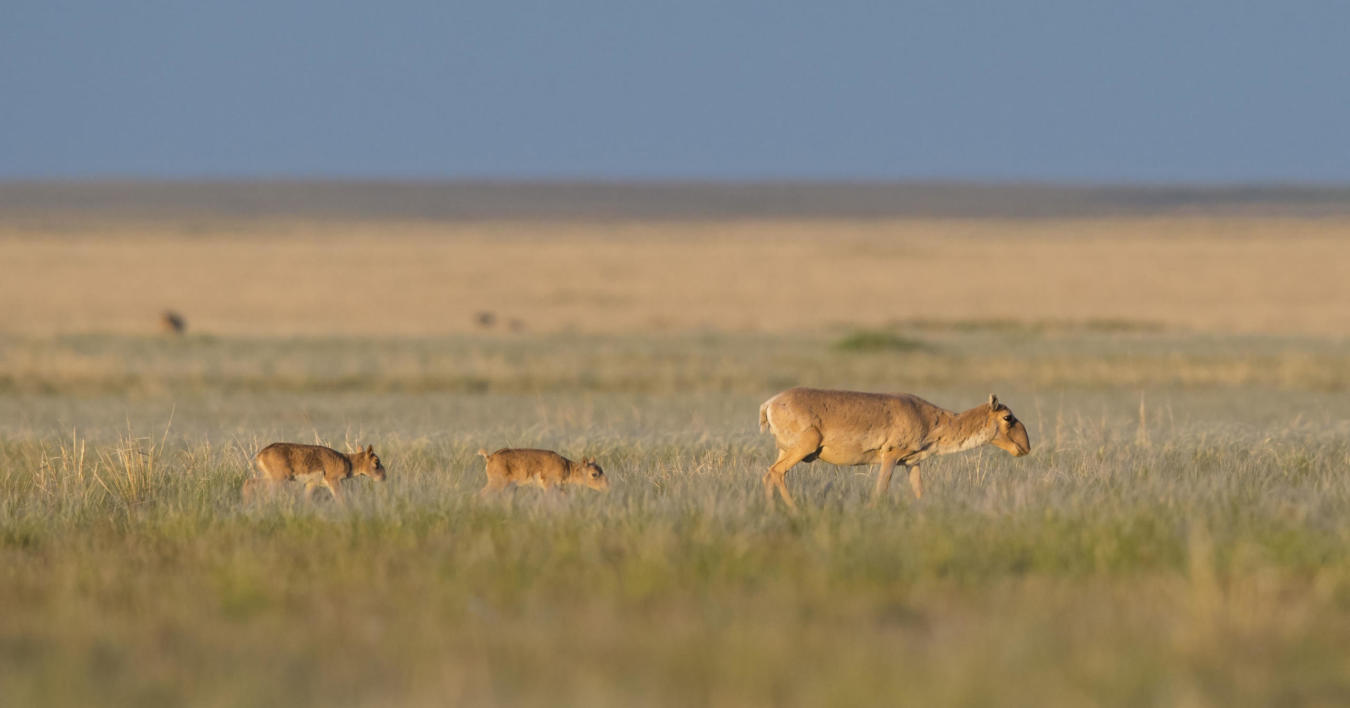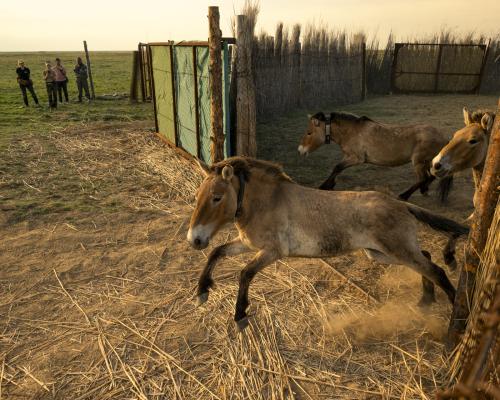This significant positive status change reflects the species’ remarkable recovery in Kazakhstan resulting from sustained ongoing conservation efforts.

Unprecedented conservation triumph – Saiga antelope reclassified from ‘Critically Endangered’ to ‘Near Threatened’ in the IUCN Red List
On 11th December 2023, the IUCN Red List status assessment of Saiga antelope (Saiga tatarica) has been changed from Critically Endangered to Near Threatened, thanks to effective national and international conservation efforts. This substantial positive change in global Red List status is a rarity in conservation, and reflects the remarkable recovery of saiga populations in Kazakhstan, which have recovered from a perilously low estimate of just 39,000 animals in 2005 to now over 1.9 million.
This triumph is thanks to significant conservation efforts over nearly two decades by Kazakh and other range state governments, research organisations, national and international NGOs, including the Saiga Conservation Alliance, the Altyn Dala Conservation Initiative (comprising the Government of Kazakhstan, the Association for the Conservation of Biodiversity of Kazakhstan [ACBK], Fauna & Flora, Frankfurt Zoological Society, the RSPB), NABU, the Wildlife Conservation Society and WWF-Mongolia. Long term support from donors has been vitally important.
As one of the most successful recoveries of a terrestrial mammal ever recorded, this is a significant milestone for the saiga antelope conservation community and illustrates how conservation can be effective if all parties collaborate with a strong mission and appropriate resourcing.
“As one of the most successful recoveries of a terrestrial mammal ever recorded, this is a significant milestone for the saiga antelope conservation community and illustrates how conservation can be effective if all parties collaborate with a strong mission and appropriate resourcing”, says Vera Voronova, Executive Director of ACBK, a Kazakh national civil society organisation and core partner of the Altyn Dala Conservation Initiative.
“We need to ensure that conservation action scales up across Kazakhstan and neighbouring countries more broadly, to ensure the long-term recovery of saiga antelope in all range states. We look forward to seeing the sustainable future of the species alongside other native wildlife to benefit steppe grassland ecosystem restoration and rural communities’ livelihoods.”
The Government of Kazakhstan has demonstrated highly commendable leadership in species recovery, investing heavily in a suite of impactful actions including anti-poaching initiatives, robust law enforcement and border control measures, and establishment of a series of major new State Protected Areas. Its enduring collaboration with civil society partners has played a crucial role in fostering a collaborative network that incorporates government agencies, conservation practitioners, academics, and international experts, and today’s celebration of success is a culmination of everyone’s efforts.
Saiga antelopes have roamed the earth since the last Ice Age, outliving iconic extinct species like woolly mammoths and sabre-toothed tigers, and play a crucial ecosystem role as a selective grazer, influencing vegetation structures, distributing nutrients, and in turn, supporting biodiversity across its habitat. There were an estimated 1 million saigas in Russia and Central Asia in the early 1990s, but by 2003 their numbers had plummeted, with only 6% of the population remaining.
The reasons for the decline are complex. Decades of uncontrolled criminal poaching for meat and horns (exported for the belief-based medicine trade in Asia), since the break-up of the former Soviet Union, led to the catastrophic fall in numbers. This, combined with the increasing development of linear and extractive infrastructure with its consequential habitat fragmentation, along with continuing illegal trade and demand in consumer countries, all combined with climate change, has spiralled the species into further decline.
The saiga conservation community has delivered a series of successful conservation interventions resulting in the boom in Kazakhstan’s saiga population seen today, and improvement in the status of the species across its range. Multiple State Protected Areas covering over 5 million hectares have been established, most recently the 657,450 hectare Bokey Orda-Ashiozek Protected Area in Western Kazakhstan. Comprehensive research and monitoring to assess the species’ populations, abundance, ecology and migration routes, and efforts to tackle poaching, are all ongoing.
The Convention on the Conservation of Migratory Species of Wild Animals (CMS) has played a crucial role in bringing governments and civil society organisations across the saiga range together, to agree on and then implement an International Work Programme on the Conservation and Sustainable Use of the Saiga Antelope, in coordination with the Convention on International Trade in Endangered Species of Wild Fauna and Flora (CITES).
FZS is proud to have been part of the dedicated efforts of the saiga conservation community and we look forward to continuing this important steppe restoration work into the future to ensure these great strides continue.
Under this Work Programme, the partners have together supported governments’ implementation of anti-poaching and law enforcement measures, formally protected key saiga habitats and monitored populations, whilst also working with local communities to raise their awareness of the issues facing saigas and to form community-led ranger teams.
“We are delighted to be able to celebrate this great moment for saiga conservation”, says Michael Brombacher, Head of Europe Department, Frankfurt Zoological Society. “FZS is proud to have been part of the dedicated efforts of the saiga conservation community and we look forward to continuing this important steppe restoration work into the future to ensure these great strides continue.”
The species will only be fully recovered if it regains its role in the ecosystem across its entire range, with ongoing poaching, illegal trade, disease, climate change, disturbance and infrastructure development all posing a threat to saiga. The species’ new Near Threatened category reflects the potential for its status to deteriorate rapidly in the absence of ongoing conservation action. The commitment from the conservation community is unwavering in its support to this iconic species.











